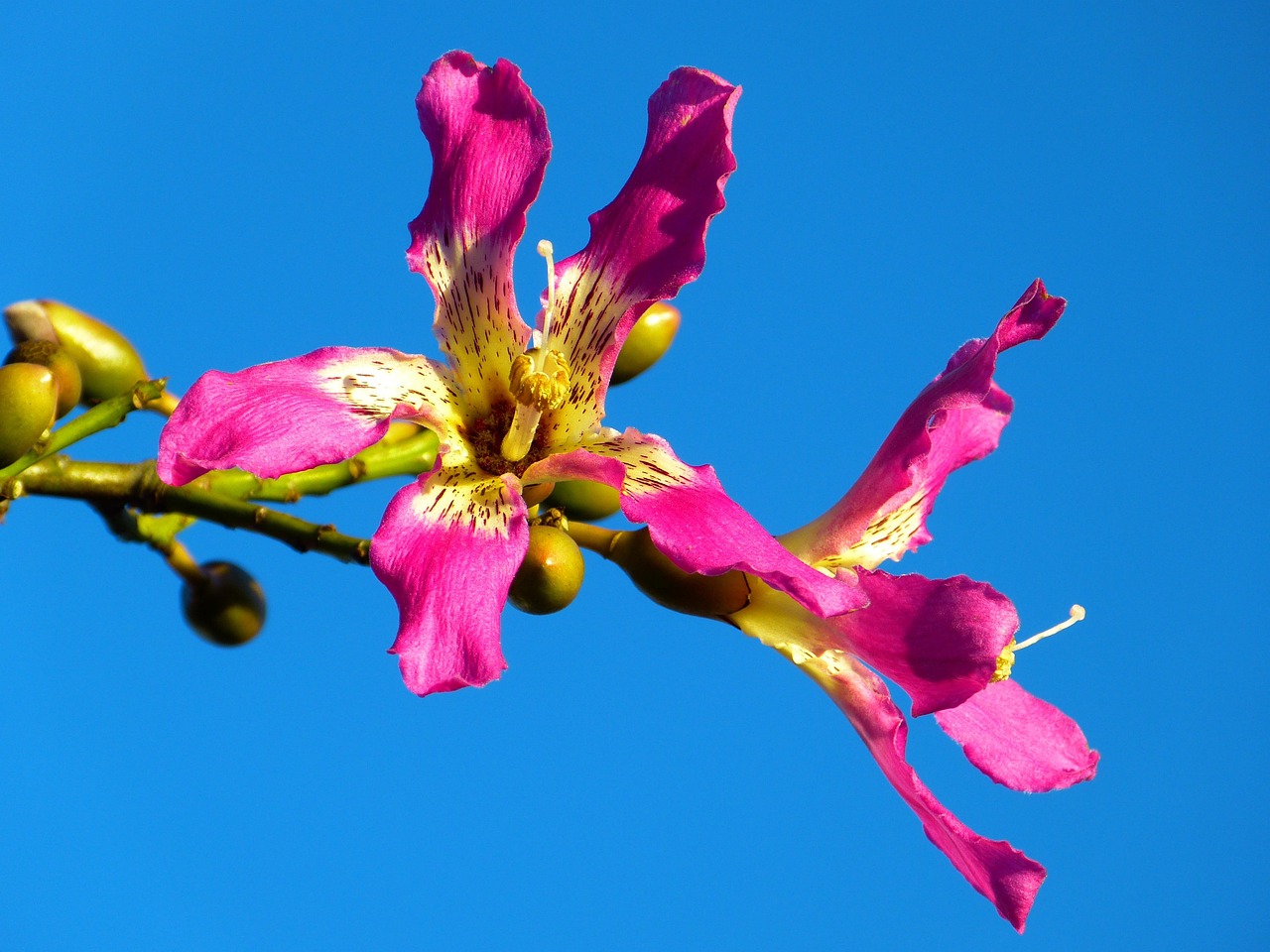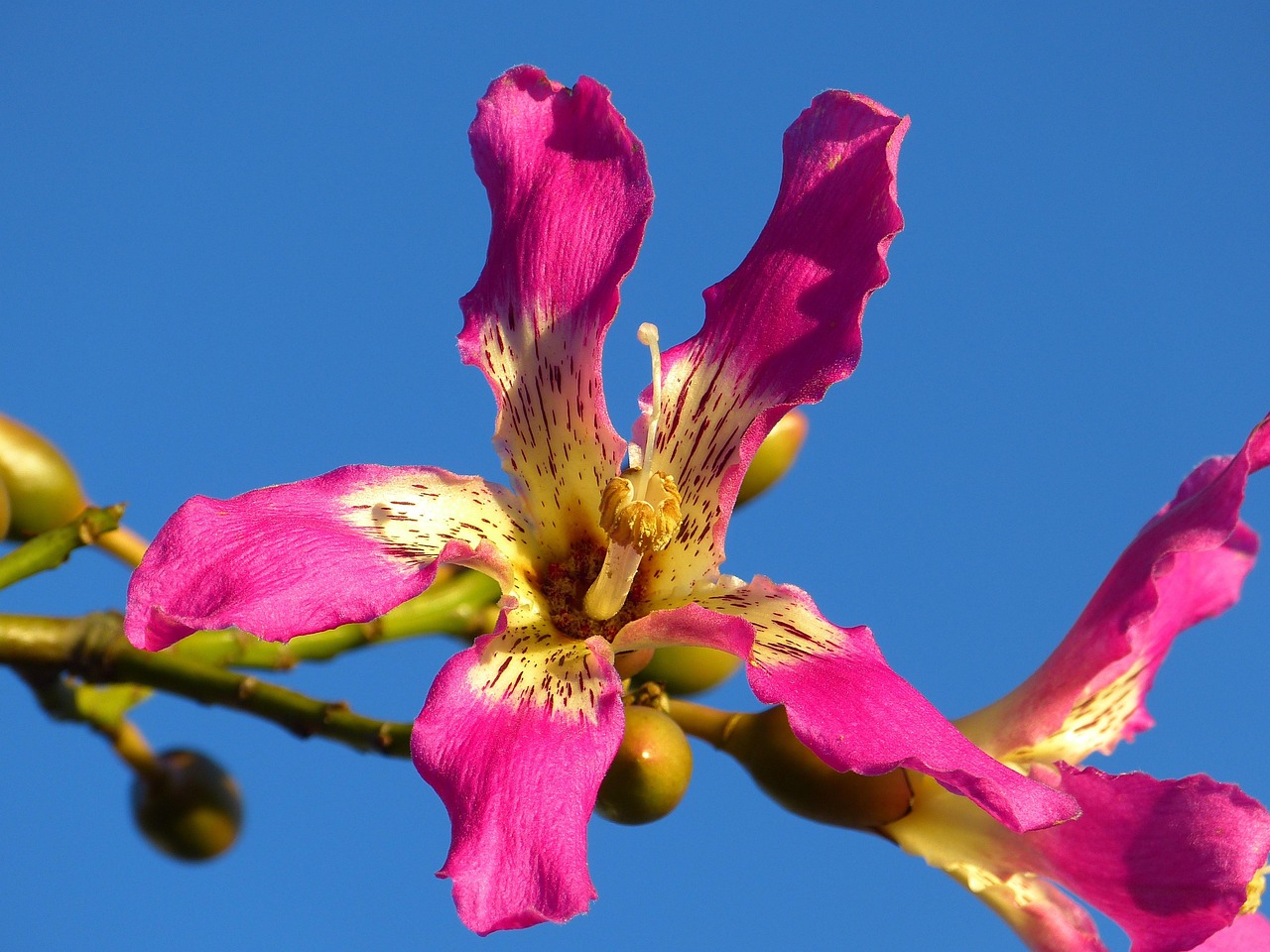The Kapok tree (Ceiba pentandra) exhibits a rapid growth rate in tropical floodplain areas, typically reaching heights of 60 to 150 feet within 10 to 15 years. Its growth is significantly influenced by the rich soil and ample water supply found in these regions.
The Kapok tree is a large tropical tree known for its impressive height and wide canopy. It is native to tropical rainforests and thrives in floodplain areas where water availability is abundant. These trees play an important role in the ecosystem, providing habitat for various species and contributing to the overall biodiversity of the region.

One of the remarkable features of the Kapok tree is its ability to grow quickly, especially in nutrient-rich environments. Floodplain areas tend to have fertile soil due to periodic flooding, which deposits organic materials and nutrients. This environment creates optimal conditions for the Kapok tree to flourish.
Factors Influencing Growth Rate
Several factors contribute to the growth rate of the Kapok tree in tropical floodplain areas. Understanding these factors is essential for conservation efforts and sustainable forestry practices. The following are key elements that influence its growth:
- Soil Fertility: The nutrient content of the soil plays a critical role. Rich, alluvial soils found in floodplains provide essential nutrients that promote faster growth.
- Water Availability: Consistent access to water during the growing season enables the tree to absorb nutrients more effectively, facilitating rapid growth.
- Sunlight: Kapok trees require ample sunlight for photosynthesis. Floodplain areas often have fewer competing trees, allowing Kapok trees to receive more light.
- Temperature: Tropical climates with warm temperatures year-round create ideal growing conditions for Kapok trees.
- Competition: The presence of other plant species can affect growth. In less competitive environments, Kapok trees can thrive better.
The interaction between these factors determines not only the growth rate but also the overall health and longevity of the Kapok tree. In areas where these conditions are optimal, trees can reach their full potential quickly.

Growth Characteristics
The Kapok tree displays unique growth characteristics that set it apart from other species. Some notable features include:
| Characteristic | Description |
|---|---|
| Height | Can grow between 60 to 150 feet tall. |
| Diameter | Can reach up to 5 feet in diameter at maturity. |
| Life Span | Can live for over 100 years under ideal conditions. |
| Seed Production | Produces large quantities of seeds, aiding in natural regeneration. |
| Root System | Develops a large, buttressed root system for stability in wet soils. |
The significant height and broad canopy of the Kapok tree make it a dominant species in its habitat. Its large seed production not only ensures its continuation but also provides food for various wildlife, further integrating it into the ecosystem.
Ecological Importance
The ecological importance of the Kapok tree cannot be overstated. It serves various functions within its environment, including:

- Habitat: The tree provides shelter and nesting sites for birds, insects, and other wildlife.
- Biodiversity: It supports a variety of organisms through its flowers and fruits, contributing to overall biodiversity.
- Erosion Control: Its extensive root system helps prevent soil erosion, especially in flood-prone areas.
In summary, the growth rate of the Kapok tree in tropical floodplain areas is a fascinating aspect of its biology. Factors such as soil fertility, water availability, and temperature play a crucial role in this process. Understanding these elements helps us appreciate the significance of this majestic tree within its ecosystem.
Growth Rates in Different Conditions
The growth rates of the Kapok tree vary significantly based on specific environmental conditions. Understanding these variations can help in managing and conserving this species effectively. The following factors are crucial in determining how fast a Kapok tree grows:
- Flood Frequency: Areas that experience regular flooding provide consistent moisture, which enhances growth rates.
- Soil Type: Sandy loam and clay soils are preferable for Kapok trees, as they retain moisture and nutrients effectively.
- Climate Variability: Changes in temperature and rainfall patterns can impact growth rates, particularly in transitional seasons.
- Competition from Other Vegetation: In areas with dense vegetation, competition for sunlight and resources may slow down growth.
Research indicates that Kapok trees can exhibit different growth patterns based on these variables. In ideal conditions, some trees can grow up to three feet per year, while in less favorable environments, the growth may slow significantly.
Growth Measurement Techniques
Measuring the growth rate of Kapok trees involves various techniques. Understanding these methods is essential for researchers and conservationists who want to track the health of these trees over time. The following are commonly used techniques:

- Height Measurement: This involves using a clinometer or measuring tape to determine the height of the tree from the base to the highest point.
- Trunk Diameter Measurement: The diameter at breast height (DBH) is measured using a diameter tape. This measurement helps assess the overall growth over time.
- Volume Estimation: Calculating the volume of the tree using mathematical formulas can provide insights into its biomass and growth rate.
- Annual Ring Analysis: Cross-section samples of the trunk may be taken to analyze growth rings, which indicate annual growth rates.
These techniques offer valuable data that can be analyzed to determine the health and growth performance of Kapok trees in various settings.
Impact of Environmental Changes
The Kapok tree’s growth and survival are influenced by environmental changes. As climate change progresses, shifts in weather patterns can have both direct and indirect effects on these trees. Key impacts include:
- Drought Conditions: Prolonged drought can lead to reduced growth rates and increased vulnerability to pests and diseases.
- Increased Flooding: While moderate flooding promotes growth, excessive flooding can damage root systems and lead to tree mortality.
- Pest Infestation: Changes in climate may lead to an increase in pest populations, which can stress trees and inhibit their growth.
- Altered Soil Chemistry: Climate change can affect soil nutrient levels, impacting the availability of essential nutrients for growth.
Monitoring these environmental changes is crucial for predicting how Kapok trees will respond in the future and for developing strategies for their conservation.
Conservation Efforts
Due to their ecological importance, conservation efforts for Kapok trees are vital. Various strategies can be employed to ensure their survival in tropical floodplain areas:
- Sustainable Forestry Practices: Implementing methods that minimize environmental impact can help maintain healthy populations of Kapok trees.
- Reforestation Projects: Planting Kapok trees in deforested or degraded areas can aid in restoring ecosystems.
- Community Involvement: Engaging local communities in conservation efforts raises awareness and promotes sustainable land use practices.
- Research Initiatives: Supporting scientific research helps improve understanding of the Kapok tree’s needs and responses to environmental changes.
The combination of these strategies can bolster the resilience of Kapok trees, ensuring their continued presence in tropical floodplain ecosystems.
Cultural Significance
The Kapok tree holds cultural significance in many tropical regions. It is often associated with various traditions and beliefs. Some aspects of its cultural relevance include:
- Symbolism: In many cultures, the Kapok tree is seen as a symbol of strength and longevity due to its impressive size and resilience.
- Traditional Uses: The fibers from its seed pods have been used for stuffing pillows and mattresses, while its wood is sometimes utilized in construction.
- Cultural Rituals: Certain communities perform rituals or celebrations centered around the Kapok tree, highlighting its importance in their cultural heritage.
This cultural connection reinforces the need to protect and conserve the Kapok tree within its natural habitat. Understanding both its ecological and cultural significance can enhance community efforts toward conservation and sustainability.
Economic Value of Kapok Trees
The Kapok tree is not only ecologically and culturally significant but also holds considerable economic value. Its various parts can be utilized to generate income for local communities and industries. Below are some key economic aspects related to the Kapok tree:
- Fiber Production: The fibers from Kapok seed pods, known as kapok, are lightweight and buoyant, making them ideal for stuffing pillows, mattresses, and life jackets.
- Timber Use: Although not as valuable as hardwoods, Kapok wood can be used in construction, furniture making, and crafts. Its lightness makes it easier to work with.
- Ecotourism: Areas rich in Kapok trees can attract tourists who are interested in nature and biodiversity, providing income through eco-friendly tourism initiatives.
- Medicinal Uses: Some cultures use parts of the Kapok tree for traditional medicine, creating an additional avenue for economic benefits if sustainably harvested.
By promoting sustainable harvesting practices, communities can benefit economically while ensuring the conservation of the Kapok tree and its ecosystem.
Propagation Methods
Effective propagation methods are essential for increasing the population of Kapok trees, particularly in areas where they are threatened. Several methods are commonly employed:
- Seed Planting: Kapok trees produce large quantities of seeds, which can be collected for planting. Seeds should be sown in nurseries before being transplanted into the field.
- Vegetative Propagation: This method involves using cuttings or grafting techniques to produce new trees from existing ones. It ensures that the new plants maintain desirable traits from the parent tree.
- Direct Seeding: In some cases, seeds can be sown directly into the ground in prepared sites. This method requires careful selection of planting locations to ensure optimal growth.
Proper care and management during the propagation phase can significantly impact the survival and growth rates of newly planted Kapok trees.
Pest and Disease Management
The Kapok tree is susceptible to various pests and diseases that can affect its growth and health. Effective management strategies are critical for ensuring that these trees thrive. Some common challenges include:
- Pests: Insects such as borers and scale insects can damage the trunk and leaves of the Kapok tree, impacting its overall health.
- Diseases: Fungal infections can lead to rot and decline in tree vigor. Regular monitoring is necessary to identify these issues early.
- Nutrient Deficiencies: Lack of essential nutrients can weaken trees, making them more susceptible to pests and diseases.
To effectively manage these challenges, landowners and conservationists may adopt integrated pest management (IPM) strategies that include:
- Regular Monitoring: Frequent inspections help identify pest infestations or disease symptoms early on.
- Biological Controls: Using natural predators or beneficial insects can help control pest populations without harming the environment.
- Cultural Practices: Maintaining soil health through proper fertilization and irrigation can enhance tree resilience against pests and diseases.
Research and Future Directions
Ongoing research on the Kapok tree is essential for understanding its growth patterns, ecological roles, and responses to environmental changes. Some promising areas of study include:
- Genetic Studies: Understanding the genetic diversity of Kapok trees can lead to improved breeding programs aimed at enhancing growth rates and disease resistance.
- Climate Adaptation Research: Investigating how Kapok trees respond to climate variability can help inform conservation strategies in a changing world.
- Sustainable Harvesting Techniques: Researching best practices for harvesting fibers and wood ensures that economic activities do not compromise ecological integrity.
Investing in research initiatives not only contributes to the sustainable management of Kapok trees but also supports broader conservation goals within tropical floodplain ecosystems.
Cultural Awareness and Education
Cultural awareness and education play a crucial role in the conservation of Kapok trees. Engaging local communities and raising awareness about their ecological and cultural significance can foster positive change. Strategies may include:
- Workshops and Training: Organizing events to educate communities about sustainable practices related to Kapok trees.
- School Programs: Incorporating lessons about local flora, including the Kapok tree, into school curricula to instill appreciation from a young age.
- Community Engagement: Encouraging community-led initiatives for planting and caring for Kapok trees can foster a sense of ownership and responsibility.
By promoting cultural awareness and education, communities can better appreciate the value of the Kapok tree while actively participating in conservation efforts.
Challenges in Conservation
Despite the significant ecological, economic, and cultural importance of the Kapok tree, several challenges hinder effective conservation. Addressing these challenges requires collaborative efforts from governments, NGOs, and local communities. The following challenges are prevalent:
- Deforestation: Rapid deforestation for agriculture and urban development poses a significant threat to Kapok trees. As their natural habitats diminish, so does their population.
- Climate Change: Changes in climate patterns can disrupt the delicate balance of tropical ecosystems, affecting the growth rates and survival of Kapok trees.
- Pest Infestation: Increasing populations of pests due to climate shifts can lead to greater damage to Kapok trees, making pest management essential.
- Overharvesting: Unsustainable harvesting of Kapok fibers and wood can lead to population declines if not managed properly.
To combat these challenges, it is crucial to implement sustainable land-use practices, create protected areas, and promote reforestation initiatives that include Kapok trees. Collaboration among stakeholders is key for effective conservation strategies.
Community-Based Management Strategies
Community involvement in the management of Kapok trees can lead to more effective conservation outcomes. Community-based management strategies can empower local populations and enhance their connection to the environment. Some strategies include:
- Participatory Resource Management: Involving local communities in decision-making processes related to forest management ensures that their needs and knowledge are incorporated.
- Incentive Programs: Providing financial incentives or support for sustainable practices can encourage communities to engage in conservation efforts.
- Traditional Knowledge Integration: Incorporating indigenous practices and traditional ecological knowledge can enhance conservation strategies by utilizing time-tested methods.
Engaging communities fosters stewardship and promotes sustainable practices that benefit both the environment and local livelihoods.
Global Perspectives on Kapok Conservation
The global perspective on Kapok tree conservation is increasingly recognized as vital due to its role in combating climate change and preserving biodiversity. Various international initiatives focus on protecting tropical forests where Kapok trees are found. These include:
- International Treaties: Agreements such as the Convention on Biological Diversity aim to protect ecosystems and species globally, including the Kapok tree.
- Collaboration with NGOs: Partnerships with non-governmental organizations can provide the necessary resources and expertise for conservation projects.
- Funding for Conservation Projects: International funding mechanisms, such as the Global Environment Facility, support projects aimed at conserving tropical forests and their biodiversity.
Through these global efforts, there is hope for the continued survival of the Kapok tree and its critical role in tropical ecosystems.
Final Thoughts
The Kapok tree is a remarkable species that serves as a cornerstone of tropical floodplain ecosystems. Its rapid growth rate, coupled with its ecological, economic, and cultural significance, underscores the necessity for effective conservation measures. Understanding its growth dynamics, propagation methods, and the challenges it faces provides a comprehensive view of its importance.
By fostering cultural awareness, promoting sustainable practices, and involving local communities in conservation efforts, we can ensure that the Kapok tree continues to thrive in its natural habitat. As we face global environmental challenges, protecting the Kapok tree is not just about preserving one species; it is about maintaining the health of entire ecosystems that countless other species depend on.
The future of the Kapok tree relies on our collective commitment to sustainability and environmental stewardship. By prioritizing conservation initiatives and supporting research efforts, we can better safeguard this majestic tree for generations to come.
